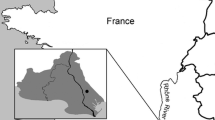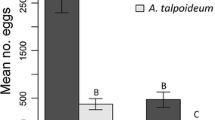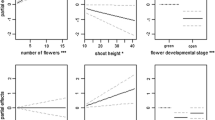Abstract
Evidence for the adaptive value of oviposition site selection in terms of increased offspring fitness is rare in predatory insects. We tested this in the damselfly Lestes macrostigma that prefers the plant Bolboschoenus maritimus. We carried out two experiments with shoots containing eggs: we flooded (1) some shoots of the same type (i.e. combination of species and desiccation state) at different dates and (2) different shoot types at the same date. Earlier flooding increased hatching success. Because B. maritimus grows in deeper parts of temporary ponds, it is flooded before other plants after the drought season, suggesting that adult oviposition site selection is driven by lower egg desiccation risk. Independently of flooding date, hatching success was higher and larvae hatched earlier when eggs were laid in B. maritimus. Faster embryonic development enhances chances to complete larval development before pond desiccation and reduces costs associated with time stress. Offspring higher fitness was more constant between shoots of B. maritimus compared to the other types of shoot, suggesting that laying eggs in one shoot of this plant leads offspring to high fitness more surely. Our results indicate that adults choose oviposition plants maximizing offspring fitness (higher hatching success and faster embryonic development).





Similar content being viewed by others
References
Adkisson, P. L., 1964. Action of the photoperiod in controlling insect diapauses. The American Naturalist 98: 357–374.
Aguesse, P. 1961. Contribution à l’étude écologique des Zygoptères de Camargue (PhD thesis). Faculté des Sciences de l’Université de Paris, Imp. CRDP Aix-en-Provence.
Arrese, E. L. & J. L. Soulages, 2010. Insect fat body: energy, metabolism, and regulation. Annual Review of Entomology 55: 207–225.
Bates, D., M. Maechler, B. Bolker B & S. Walker, 2016. lme4: Linear mixed-effects models using Eigen and S4. R package version 1.1–12. http://CRAN.R-project.org/package=lme4.
Béthoux, O., J. Galtier & A. Nel, 2004. Earliest evidence of insect endophytic oviposition. Palaios 19: 408–413.
Bolker, B. M., 2008. Ecological models and data in R. Princeton University Press, Princeton.
Borisov, S. N., 2005. Aperiodic changes in number of Lestes macrostigma (Eversmann, 1836) in forest-steppe of West Siberia. Euroasian Entomological Journal 4: 30–32.
Boudot, J.-P. & R. Raab, 2015. Lestes macrostigma (Eversmann, 1836). In Boudot, J.-P. & V. J. Kalkman (eds), Atlas of the European dragonflies and damselflies. KNNV Publishing, Zeist: 58–60.
Buskirk, R. E. & K. J. Sherman, 1985. The influence of larval ecology on oviposition and mating strategies in dragonflies. Florida Entomologist 68: 39–51.
Carchini, G., V. Della Bella, A. G. Solimini & M. Bazzanti, 2007. Relationships between the presence of odonate species and environmental characteristics in lowland ponds of central Italy. International Journal of Limnology 43: 81–87.
Corbet, P. S., 1956. The influence of temperature on diapause development in the dragonfly Lestes sponsa (Hansemann) (Odonata: Lestidae). Proceedings of the Royal Entomological Society of London 31: 45–48.
Corbet, P. S., 2004. Dragonflies: behaviour and ecology of Odonata, Revised ed. Harley Books, Colchester.
De Block, M. & R. Stoks, 2004. Life-history variation in relation to time constraints in a damselfly. Oecologia 140: 68–75.
De Block, M. & R. Stoks, 2005. Fitness effects from egg to reproduction: bridging the life history transition. Ecology 86: 185–197.
De Block, M., R. Stoks & L. De Bruyn, 2005. Egg hatching patterns within and among populations of a damselfly occupying permanent and temporary ponds. Archiv für Hydrobiologie 163: 195–209.
De Block, M., M. A. McPeek & R. Stoks, 2008. Life-history evolution when Lestes damselflies invaded vernal ponds. Evolution 62: 485–493.
Díaz-Paniagua, C., R. Martín-Franquelo & P. Fernández Díaz, 2015. Ecología de Lestes macrostigma en las lagunas temporales de Doñana. Simposio Ibérico de Odonatología, Córdoba.
Florencio, M. & C. Díaz-Paniagua, 2012. Presencia de Lestes macrostigma (Eversmann, 1836) (Odonata: Lestidae) en las lagunas temporales del Parque Nacional de Doñana (sudoeste de España). Boletín de la Sociedad Entomológica Aragonesa 50: 579–581.
Fox, J., S. Weisberg, M. Friendly, J. Hong, R. Andersen, D. Firth & S. Taylor, 2016. Effect displays for linear, generalized linear, and other models. R package version 3.1-2. https://cran.r-project.org/web/packages/effects/effects.pdf.
French, S. K. & S. J. McCauley, 2018. Canopy cover affects habitat selection by adult dragonflies. Hydrobiologia. https://doi.org/10.1007/s10750-018-3600-5.
García-Robledo, C. & C. C. Horvitz, 2012. Parent-offspring conflicts, “optimal bad motherhood” and the “mother knows best” principles in insect herbivores colonizing novel host plants. Ecology and Evolution 2: 1446–1457.
Gelman, A. & J. Hill, 2006. Data Analysis Using Regression and Multilevel/Hierarchical Techniques. Cambridge University Press, Cambridge.
Goula, M., 2008. Parental care in Heteroptera (Hemiptera: Prosorhynche). In Capinera, J. L. (ed.), Encyclopedia of Entomology. Springer, Berlin: 2743–2755.
Gower, J. L. & E. J. Kormondy, 1963. Life history of the damselfly Lestes rectangularis with special reference to seasonal regulation. Ecology 44: 398–402.
Grillas, P., P. Gauthier, N. Yavercovski & C. Perennou, 2004. Mediterranean temporary pools. Vol. 1 Issues related to conservation, functioning and management. Station Biologique de La Tour du Valat, Arles.
Grunert, H., 1995. Eiablageverhalten und Substratnutzung von Erythromma najas (Odonata: Coenagrionidae). Braunschweiger Naturkundliche Schriften. 4: 769–794.
Hirayama, H. & E. Kasuya, 2009. Oviposition depth in response to egg parasitism in the water strider: high-risk experience promotes deeper oviposition. Animal Behaviour 78: 935–941.
Janz, N., 2002. Evolutionary ecology of oviposition strategies. In Hilker, M. & T. Meiners (eds), Chemoecology of Insect Eggs and Egg Deposition. Blackwell, Malden: 349–376.
Kalkman, V. J., J.-P. Boudot, R. Bernard, K.-J. Conze, G. De Knijf, E. Dyatlova, S. Ferreira, M. Jović, J. Ott, E. Riservato & G. Sahlén, 2010. European Red List of Dragonflies. Publications Office of the European Union, Luxembourg.
Knorp, N. E. & N. J. Dorn, 2016. Mosquitofish predation and aquatic vegetation determine emergence patterns of dragonfly assemblages. Freshwater Science 35: 114–125.
Knowles, J. E. & C. Frederick, 2016. Tools for analyzing mixed effect regression models. R package version 0.3.0. https://cran.r-project.org/web/packages/merTools/index.html.
Lambret, P., D. Cohez & A. Janczak, 2009. Lestes macrostigma (Eversmann, 1986) en Camargue et en Crau (Bouches-du-Rhône, France) (Odonata, Zygoptera: Lestidae). Martinia 25: 51–65.
Lambret, P., N. Matushkina & A. Besnard, 2015a. Initial preference for plant species and state during oviposition site selection by an odonate. Entomological Science 18: 377–382.
Lambret, P., A. Besnard & N. Matushkin, 2015b. Plant preference during oviposition in the endangered dragonfly Lestes macrostigma (Odonata: Zygoptera) and consequences for its conservation. Journal of Insect Conservation 19: 741–752.
Lambret, P., S. Hilaire & R. Stoks, 2017. Egg hatching phenology and success of Lestes macrostigma in two temporary brackish ponds. International Journal of Odonatology 20: 1–12.
Martens, A., 2001. Initial preference of oviposition sites: discrimination between living and dead plant material in Sympecma fusca and Coenagrion caerulescens (Odonata: Lestidae, Coenagrionidae). European Journal of Entomology 98: 121–123.
Martynov, A. V. & V. V. Martynov, 2007. Biology of Lestes macrostigma (Odonata: Lestidae) in Southeastern Ukraine. The Kharkov Entomological Society Gazette 15: 185–192.
Mattingly, W. B. & S. L. Flory, 2010. Plant architecture affects periodical cicada oviposition behavior on native and non-native hosts. Oikos 120: 1083–1091.
Matushkina, N. & P. Lambret, 2011. Ovipositor morphology and egg laying behaviour in the dragonfly Lestes macrostigma (Zygoptera: Lestidae). International Journal of Odonatology 14: 69–82.
Matushkina, N., P. Lambret & S. Gorb, 2016. Keeping the Golden Mean: plant stiffness and anatomy as proximal factors driving endophytic oviposition site selection in a dragonfly. Zoology 119: 474–480.
Mesléard, F., J. Lepart, P. Grillas & A. Mauchamp, 1999. Effects of seasonal flooding and grazing on the vegetation of former ricefields in the Rhône delta (Southern France). Plant Ecology 145: 101–114.
Pasquier-Barre, F., C. Palasse, F. Goussard, M.-A. Auger-Rozenberg & C. Géri, 2001. Relationship of scots pine clone characteristics and water stress to hatching and larval performance of the sawfly Diprion pini (Hymenoptera: Diprionidae). Environmental Entomology 30: 1–6.
Paulson, D. R., 2012. Dragonflies and Damselflies of the East. Princeton University Press, Princeton.
Paulson, D.R. 2017. Ischnura kellicotti. The IUCN Red List of Threatened Species 2017: e.T51361680A65836774. http://dx.doi.org/10.2305/IUCN.UK.2017-3.RLTS.T51361680A65836774.en. Downloaded on 25 April 2018.
Pinheiro, J., D. Bates, S. DebRoy, D. Sarkar, EISPACK authors, S. Heisterkamp & B. Van Willigen, 2017. Linear and nonlinear mixed effects models. R package version 3.1-131. https://cran-project.org/web/packages/nlme/nlme.pdf.
Rausher, M. D., 1979. Larval habitat suitability and oviposition preference in three related butterflies. Ecology 60: 503–511.
R Core Team, 2016. R: A language and environment for statistical computing. R Foundation for Statistical Computing.
Reinhardt, K. & U. Gerighausen, 2001. Oviposition site preference and egg parasitism in Sympecma paedisca (Odonata: Lestidae). International Journal of Odonatology 4: 191–200.
Ripley, B., B. Venables, D.M. Bates, K. Hornik, A. Gebhardt & D. Firth, 2018. Support functions and datasets for Venables and Ripley’s MASS. R package version 7.3-50. https://cran.r-project.org/web/packages/MASS/MASS.pdf.
Rueda, L. M., K. J. Patel, R. C. Axtell & R. E. Stinner, 1990. Temperature-dependent development and survival rates of Culex quinquefasciatus and Aedes aegypti (Diptera, Culicidae). Journal of Medical Entomology 27: 892–898.
Samways, M. J., 2007. Insect conservation: a synthetic management approach. Annual Review of Entomology 52: 465–487.
Sawchyn, W. W. & C. Gillot, 1974. The life histories of three species of Lestes (Odonata: Zygoptera) in Saskatchewan. Canadian Entomologist 106: 1283–1293.
Schiel, F. J. & R. Buchwald, 2015a. Hatching phenology of Odonata species inhabiting temporary and permanent water bodies (Odonata: Lestidae, Aeshnidae, Libellulidae). International Journal of Odonatology 18: 105–123.
Schiel, F. J. & R. Buchwald, 2015b. Contrasting life-history patterns between vernal pond specialists and hydroperiod generalists in Lestes damselflies (Odonata: Lestidae). Odonatologica 44: 349–374.
Sgolastra, F., W. P. Kemp, J. S. Buckner, T. L. Pitts-Singer, S. Maini & J. Bosch, 2011. The long summer: Pre-wintering temperatures affect metabolic expenditure and winter survival in a solitary bee. Journal of Insect Physiology 57: 1651–1659.
Siva-Jothy, M. T., D. W. Gibbons & D. Pain, 1995. Female oviposition-site preference and egg hatching success in the damselfly Calopteryx splendens xanthostoma. Behavioral Ecology and Sociobiology 37: 39–44.
Śniegula, S., M. J. Gołąb & F. Johansson, 2016. Time constraint effects on phenology and life history synchrony in a damselfly along a latitudinal gradient. Oikos 125: 414–423.
Srivastava, D. S., M. C. Melnychuk & J. T. Ngai, 2005. Landscape variation in the larval density of a bromeliad-dwelling zygopteran, Mecistogaster modesta (Odonata: Pseudostigmatidae). International Journal of Odonatology 8: 67–79.
Stoks, R. & A. Cordoba-Aguilar, 2012. Evolutionary ecology of Odonata: a complex life cycle perspective. Annual Review of Entomology 57: 249–265.
Stoks, R., M. De Block, S. Slos, W. Van Doorslaer & J. Rolff, 2006. Time constraints mediate predator-induced plasticity in immune function, condition, and life history. Ecology 87: 809–815.
Suhonen, J., E. Suutari, K. M. Kaunisto & I. Krams, 2013. Patch area of macrophyte Stratioites aloides as a critical resource for declining dragonfly Aeshna viridis. Journal of Insect Conservation 17: 393–398.
Sweeney, J. & D. T. Quiring, 1998. Oviposition site selection and intraspecific competition influence larval survival and pupal weight of Strobilomyia neanthracina (Diptera: Anthomyiidae) in white spruce. Écoscience 5: 454–462.
Tilmon, K. J., 2008. Specialization, speciation, and radiation: The evolutionary biology of herbivorous insects. University of California Press, Oakland.
Zuur, A. F., E. N. Ieno, N. J. Walker, A. A. Saveliev & G. M. Smith, 2009. Mixed effects models and extensions in ecology with R. Springer-Verlag, New York.
Acknowledgements
We are grateful to the Amis des Marais du Vigueirat and to the Regional Natural Reserve of the Tour du Valat, for the permission to access the protected areas. We thank Jared Knowles for his advice regarding the assessment of the effects of the random factor. Marc Solari translated the paper of Horst Grunert into French. Alexandre Vilain helped us in the field. We are also grateful to Associate Editor Dani Boix and two anonymous reviewers, whose comments and suggestions helped us to improve an earlier version of the manuscript.
Author information
Authors and Affiliations
Corresponding author
Additional information
Handling editor: Dani Boix
Rights and permissions
About this article
Cite this article
Lambret, P., Rutter, I., Grillas, P. et al. Oviposition plant choice maximizes offspring fitness in an aquatic predatory insect. Hydrobiologia 823, 1–12 (2018). https://doi.org/10.1007/s10750-018-3663-3
Received:
Revised:
Accepted:
Published:
Issue Date:
DOI: https://doi.org/10.1007/s10750-018-3663-3




